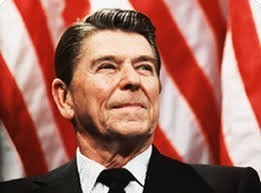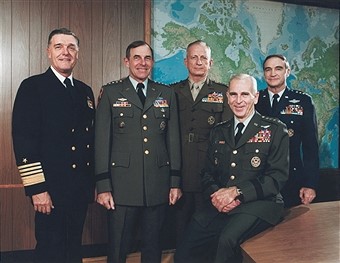“I didn’t take this job so that we could regain parity with our adversaries. As I’ve taken to saying: ‘I want to see their hand and raise them one. I want to make them worry about catching up with us again. . . Any American, any ally or partner that we have who doesn’t see it that way, I don’t have time for you.’” Under Secretary of Defense for Research and Engineering Mike Griffin
I love these fighting words, especially this week as we remember President Ronald Reagan’s March 23, 1983 speech that launched his Strategic Defense Initiative (SDI) that many, including his great partner then the United Kingdom’s Prime Minister Margaret Thatcher, believe hastened the end of the Cold War. And yours truly.
Many of us remember numerous memorable Reagan quotations — including a notable quip that reminds me of Mike’s summary perspective, e.g., Reagan’s quick summary of his strategy goal re. the Soviet Union: “We win; they lose!”
And of course, Reagan backed up that summary aspiration with actions — e.g., his rebuilding of our military forces that had atrophied from years of neglect following Viet Nam; e.g., what then Army Chief of Staff Shy Meyer called the “hollow force.” President Reagan also responded to the complementary views of the other Chiefs. The Navy and Air Force returned to their historic preeminent command of the oceans, the seas and the air.
His Strategic Modernization program repaired the deteriorating conditions of our land-, sea- and air-based strategic deterrent forces, permitting the United States to lead from a position of strength in its strategic arms negotiations with the Soviet Union — Reagan’s agenda was to pursue “Peace through Strength” — a perspective now reflected by President Trump’s strategy and announced intended practice.
It is also worth noting that President Reagan had no stronger supporters than the Joint Chiefs of Staff (including General Meyer), when he undertook his SDI program. Indeed, they were there when it counted most in the lead-up to President Reagan’s historic speech 35 years ago this coming Friday. As shown below, they were (standing left to right) Admiral James D. Watkins, Army General Edward C. “Shy” Meyer, Marine General Robert H. Barrow, Air Force General Charles A Gabriel and (seated) Chairman Army General John W. (Jack) Vessey.
Click here and here for a sample of my previous discussion of these historic times and that the Chiefs stood with Reagan subsequently when the elite arms control community, in concert with the Soviets and others, sought to undermine those efforts they claimed would end all arms control efforts.
I spent five years at the negotiating table with the Soviets and in regular meetings with our allies, disputing those claims, and afterward when serving as President George H.W. Bush’s SDI Director in seeking to work with the Russians to build a Joint Global Defense — while we achieved the first strategic arms control agreements ever to reduce nuclear arms.
This agenda was derived from Reagan’s vision, which included unabashedly an important global role for space-based defenses — as historically illustrated when he walked out of the October 11-12, 1986 Reykjavik Summit. He was derided by his opponents who alluded to SDI as a Star Wars fantasy.
Reagan’s perspective was abandoned with the advent of the Clinton administration that “took the stars out of Star Wars,” as then Defense Secretary Les Aspin claimed. Even more destructively, the Clinton administration returned to Cold War rhetoric that strategic stability depended upon underwriting the Mutual Assured Destruction (MAD) doctrine of the Cold War — a perspective totally rejected by President Reagan.
He instead sought cooperation with the Soviets/Russians in building effective ballistic missile defense, including those based in space — I’ll never forget receiving his specific instruction to propose that we open our national laboratories for the Soviets to visit and see our SDI efforts first hand. I called on a secure line to receive further instructions from Washington, and was told: “Wing it!”
This instruction came directly from the President. And so we did — and among the last things I did as Chief Negotiator was to make specific plans for the Soviet Delegation to visit several of our national laboratories and other key SDI related facilities.
We continued that “Open Laboratories” approach through the Bush-41 years, during which as SDI Director I remained close to our negotiations in Geneva. And we were eventually rewarded when Russia’s President Boris Yeltsin proposed in January 1992 at the United Nations that the SDI program take advantage of Russian technology and that we work together to build a “Joint Global Defense” to protect the world community.
In effect Yeltsin said “yes” to Reagan’s proposal that I delivered in Geneva — and continued to advocate as SDI Director.
I brought Russian scientists and engineers to the United States to underwrite our seriousness in pursuing this objective, as others conducted high level talks through the remainder of the Bush-41 administration. But this cooperative approach was abandoned outright by the Clinton administration.
At the first Clinton-Yeltsin Summit in Vancouver, when Russian negotiators sought to continue what we had done during the Reagan-Bush-41 years, our side was completely unprepared. Associated policies eroded the progress that had been made at the negotiating table with Russia as both sides reverted to Cold War thinking — a view that Vladimir Putin is now making abundantly clear in the current political scene.
Addressing this situation is now President Trump’s challenge. As he proceeds, I hope he will remember President Reagan’s approach and that he observes that the current challenging situation is not unlike the one addressed in Reagan’s first term.
We again have military forces that have deteriorated over past decades and have ignored for a quarter century the most cost-effective missile defenses pursued by Reagan’s SDI efforts — a condition now recognized by a growing number of military leaders.
Of particular interest is reviving development of space-based defenses like Brilliant Pebbles — the first SDI effort actually to be fully approved by the Pentagon’s Defense Acquisition Board as a formal Major Defense Acquisition Program (MDAP) to enter a formal Demonstration and Validation (DemVal) phase in 1990.
To return to my entre in this message, USD(R&E) Mike Griffin was there in the beginning; he was a key participant in building the negotiating leverage provided by the SDI effort during my predecessors’ watch as SDI Directors — and he was my first Deputy for Technology. He has been a close advisor to subsequent missile defense acquisition executives — including USAF LGen. Sam Greaves, the current Missile Defense Agency Director, who now works for Mike.
The signs are truly positive.
If you live in the Washington area, you might wish to attend a conference at the Heritage Foundation between 1000 and 1200 on Thursday when I will be joining others to fill in further details in my message above and last week, when I emphasize the strong Pentagon team now forming, which can indeed take us “back to the future.” See below.
If you can make it, please RVSP to the Heritage Foundation per clicking here, and if you can’t make it, note you can watch it live via the web, on March 22 at www.heritage.org . 
Co-hosted by
American Foreign Policy Council and Reagan Alumni Association
~ Honoring President Ronald Reagan’s Legacy ~

Defending American Citizens:
The Strategic Defense Initiative
Welcome and Introduction
Becky Norton Dunlop, Ronald Reagan Distinguished Fellow, The Heritage Foundation
Opening Presentations
Sven Kraemer, President Reagan’s National Security Council Director for Arms Control (1981-1987) and Distinguished Fellow, American Foreign Policy Council
Ambassador Henry Cooper, Chairman, High Frontier; President Reagan’s Chief Negotiator at the Geneva Defense and Space Talks; and former Director of the Strategic Defense Initiative Office
Commentaries and Historical Perspectives
Peter Huessy, Director of Strategic Deterrent Studies, Mitchell Institute for Aerospace Studies, and President, GeoStrategic Analysis – Co-Host and Discussion Leader
Ambassador Robert Joseph, Senior Scholar, National Institute for Public Policy; Professor, Missouri State University; and former U.S. Special Envoy for Nuclear Nonproliferation and former Under Secretary of State for Arms Control and International Security
Ilan Berman, Senior Vice President, American Foreign Policy Council
Lt. General Daniel Leaf, USAF (ret.), Former Deputy Commander of the U.S. Pacific Command
Adjournment / Light Luncheon Buffet Provided
The President Ronald Reagan Legacy Project will honor the multiple policy initiatives and legacies America inherited as a result of President Reagan’s vision, intentions, and actions that established the foundation for constitutional public policy pointing the way forward even today. Defending the citizenry was among his highest priorities and a role he believed was the central constitutional responsibility of the national government. Our first program will, therefore, address his announcement of the Strategic Defense Initiative (SDI) and the goal to protect American security from not only established enemy states, but also rogue regimes or terrorist groups who could launch nuclear weapons on the United States or our allies and examine how this vision is relevant to today’s missile defense challenges.
Thursday, March 22, 2018 – 10:00 a.m. to 12:00 p.m.
The Heritage Foundation’s Lehrman Auditorium
RSVP online, or call (202) 675-1752
All events may be viewed live at heritage.org
News media inquiries, call (202) 675-1761
214 Massachusetts Avenue, NE | Washington, D.C. 20002 | (800) 546-2843
Bottom Lines.
So we have a great team in the making in the Pentagon to revive the best of the SDI era and move beyond those advances, based on all that has happened since it ended a quarter century ago.
President Trump’s interest in forming a “Space Force” signals that he should be receptive to that return to the aspirations and efforts of Ronald Reagan’s SDI era.
And as noted in my messages the last couple of weeks in reacting to Putin’s bluster, remember “Forewarned is Forearmed!”
How the pending Missile Defense Review executes the President National Strategic Strategy will tell the tale!
Stay tuned . . .
What can you do?
Join us in praying for our nation, and for a rebirth of the freedom sought, achieved and passed to us by those who came before us.
Help us to spread our message to the grass roots and to encourage all “powers that be” to provide for the common defense as they are sworn to do.
Begin by passing this message to your friends and suggest they visit our webpage www.highfrontier.org, for more information. Also, please encourage your sphere of influence to sign up for our weekly e-newsletter.
Encourage them to review our past email messages, posted on www.highfrontier.org, to learn about many details related to the existential manmade and natural EMP threats and how we can protect America against them. I hope you will help us with our urgently needed efforts, which I will be discussing in future messages.
Click here to make a tax deductible gift. If you prefer to mail a check, Please send it to 500 North Washington Street, Alexandria, VA 22314.
E-Mail Message 180320
Please click here to read Past Weekly Updates!
Please help High Frontier continue this important and timely work!
Be sure to follow us on our Social Sites!
If you found this letter via our Social Sites, and you would like to subscribe, please click below!






